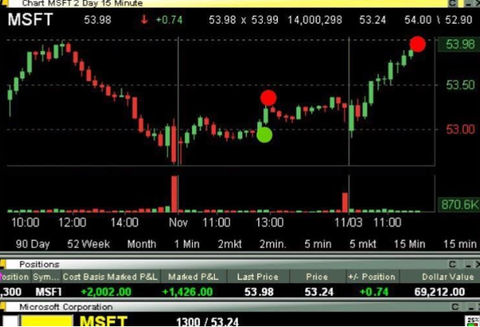Risk Reward, "Penthouse or Poor house"
Pick your favorite stock that you would buy at today price.
What would your stop loss be?
At what price would you want to sell it for a profit?
Now based on your risk vs reward, what is the ratio? 1:1, 2:1, 10:1, etc, write it down so you can compare yourself to what professional traders and billionaires aim for when looking at risk reward.

Question 1.
In this MSFT trade, we bought 2000 shares at $53 and our stop was $52.90 so we are risking $.10 per share and our first sell was just under the half, so we sold for around a $.50 profit, what is the average risk reward so far in this trade?
A.1:1 Risk Reward
B.5:1 Risk Reward
C.7:1 Risk Reward
D.8:1 Risk Reward
After you answer these questions we will move onto an example on proper risk reward!
Proper Risk Reward
You bought the stock you picked today, where would you get out if the stock started to show a loss? If you have a defined (stop) out where you will take a loss if the trade fails, you will limit having those painful big losses most new traders learn the hard way. By having a stop, which is a price below your entry that you will sell for a loss if it gets down there to cut your loss and limit further losses if the stock continues to fall.
By setting a stop loss you are determining your risk in that particular trade to limit your downside. By defining your max loss you are willing to take on your investment, you can now figure out the ideal profit!
You want to focus on taking trades where you can make 5:1 on your risk or better. But why? Keep reading and you will find out.
Question 2
So lets say you are risking $100 in a trade what should be your minimum profit target?
A. $100
B. $500
C. $550
D. $750

(This is Ray Dalio, a BSD, worth Billions)
If you can strive to aim for 5:1 risk reward or greater you will have a better chance at being successful. Why do we say this? Well let’s hear from Ray Dalio, one of the most successful hedge fund managers of the last century.
“The average person goes out and invests a dollar hoping to make 10% or 20%, if they’re lucky — so if they’re wrong they’re in the hole majorly.
Paul Tudor Jones had a principle he used to use called 5:1. And 5:1 is this: If he invests a dollar, he doesn’t part with that dollar he’s investing unless he feels certain he’s going to make five.
He knows — he’s not stupid — he knows he’s going to be wrong [sometimes] so if he loses a dollar and has to spend another dollar, spending two to make five, he’s still up $3.
He can be wrong four out of five times and still be in great shape.
Most everybody thinks that if I want to get big rewards I need to take huge risks. But if you keep thinking that, you’re gonna be broke.”
Spend some time to really learn this because we will be building off the idea of risk reward in our next lesson "Finding a Bull Flag", and the correct answer was in Question 1 was B 5:1 Risk Reward! Question 2 was also B $500.
Fill out a new game plan of your favorite stock below with your new knowledge on risk reward and compare the difference between not knowing of proper risk reward and your new found knowledge of it. If you game plan is still the same, you should re read the lesson a few times over.
Game Plan
What is your entry price?
What is your stop?
Why is your stop their?
What is your ideal target price to sell at?
What is the risk reward ratio?
Here is some Definitions to help you understand the major parts of your game plan
1) "Entry Price" Defined: Based on technical analysis, these are typically levels of support and resistance that, if breached, could potentially lead to momentum in a given direction.
2) "Target Range" Defined: Target range is the price range which the stock could potentially reach, based on your opinion
3) "Stop-Loss Level" Defined: Level that you could potentially place a stop-loss order on the hypothetical trade in order to manage risk. However, all actual trading decisions are made independent of the information provided here.


